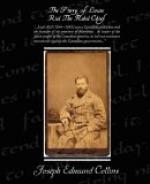“The first overt act of treason was committed,” continued Mr. Osler, “when the French half-breeds were requested by Riel to bring their arms with them to a meeting to be held at Batoche on March 3rd. This indicated that the prisoner intended to resort to violence. On the 18th instant they find him (Riel) sending out armed men and taking prisoners, including Mr. Lash, the Indian agent of the St. Lament region, and others, also looting the stores at and near Batoche, stopping freighters and appropriating their freight. A few days later the French half-breeds were under arms, and were joined by the Indians of the neighbourhood, who were incited to rise by the prisoner. On the 21st inst. Major Crozier did all he could to get the armed men to disperse, but directed by Riel, they refused to do so, and taking their orders from him, they continued in rebellion. He held a document in his hands, in the prisoner’s handwriting,” added Mr. Osler, “which contained the terms on which Fort Carlton would be spared attack by the surrender and march out of Major Crozier and the mounted police. This document was never delivered, but was found with other papers in the rebel council chamber after the taking of Batoche. It was said in this notification to Crozier that the rebels would attack the police if they did not vacate Carlton, and would commence a war of extermination of the white race. This document was direct evidence of the treasonable intentions of the prisoner. Ten days previously Riel declared himself determined to rule or perish, and the declaration was followed by this demand. It would be said that, at last, when a clash of arms was imminent, Riel objected to forcible measures; but this document was a refutation of that assertion. At Duck Lake the prisoner had taken upon himself the responsibility of ordering his men to fire on the police. At Fish Creek, if Riel was not there, he directed the movement, and was therefore responsible. On the day of the fight he went back to Batoche to finish the rifle-pits. In the contest at Batoche the prisoner was seen bearing arms, and giving such directions as would show that he was the main mover. His treatment of the prisoners, his letters to Middleton, and other documents would show Riel’s leadership. A letter found in Poundmaker’s camp would show his deliberate intention of bringing on this country the calamity of an Indian war. All this would be proven, and it would be shown that the prisoner had not come here to aid his friends in the redress of grievances, but in order to use the half-breeds for his own selfish ends.” Mr. Osler closed with a reference to the death and suffering which had been caused by the ambition of one man, and impressed upon the jury the grave responsibility they were charged with in bringing his crime home to the prisoner.




